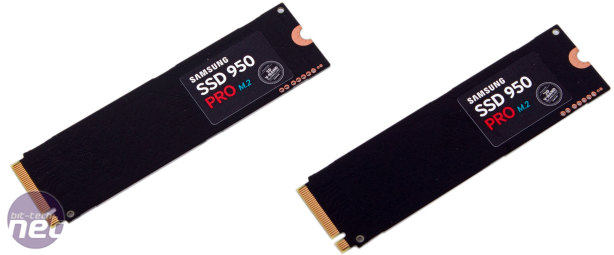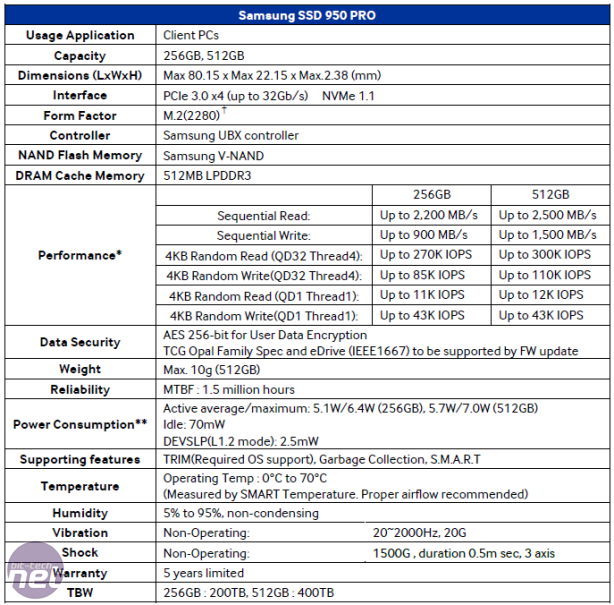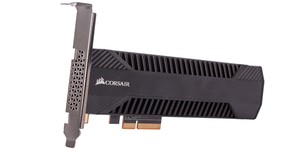
Samsung SSD 950 Pro Preview
You’ll be seeing reviews of Samsung’s SSD 950 Pro going live all around the web this afternoon, as today is the day the NDA lifts on reviews and performance figures. However, we unfortunately will not be able to do the same due to issues we’ve run into while testing both the 256GB and 512GB drives. As such, we wanted to offer a brief explanation of and apology for this as well as take the chance to look more closely at what the drives are about.So, firstly, the problem. Our SSD test system was updated this year to an X99 system using the Asus Rampage V Extreme and an Intel Core i7-5960X; a combination which, in theory left us in the perfect position to test and review all manner of upcoming PCI-E storage devices.
However, upon connecting and running our initial tests (CrystalDiskMark), we discovered that both drives were limited to around 1,700MB/sec in read speeds. This is clearly still very fast, but it should be hitting around 2,200MB/sec (256GB) and 2,500MB/sec (512GB). The issue persisted after all the usual troubleshooting, and we were able to verify that our drives were working properly on an external test system (sadly not one that we have permanent access too). There's little reason boring you with further details. We've been back and forth with both Asus and Samsung and it's now looking like a problem specific to our board, but ultimately we’ve not been able to get a replacement test system together in time. We do take some responsibility for this and apologise, and we are working on getting one as soon as possible, but for now that’s where we’re at.
With that out the way, let’s take a closer look at the Samsung SSD 950 Pro. The drive is available in two capacities only – 256GB and 512GB – and in one form factor: single-sided M.2 2280. Most M.2 ports take 2280 drives (it means they’re 80mm long) but some don’t, so always check to avoid disappointment.
Much like Samsung’s own SM951, this is a PCI-E controlled drive rather than a SATA one. The M.2 form factor is not the only way to utilize PCI-E lanes, but it is currently the most popular. You can also have add-in cards and U.2 drives (formerly SFF-8639), but Samsung has not hinted at a 950 Pro release in either of these. SATA Express is technically a fourth alternative, but the quicker that’s forgotten about the better.
The 950 Pro uses the NVMe interface, and is Samsung’s first consumer drive to do so (the SM951 is classified as OEM, and has both NVMe and AHCI variants). The NVMe protocol is specifically designed with PCI-Express in mind, leveraging it to exploit the massive parallelism inherent to SSDs and the multiple cores of modern processors and resulting in potentially huge gains in performance and efficiency compared to AHCI devices.
As usual, the new drive is built entirely in-house by Samsung. At its heart is the UBX controller. This is the same as the SM951 but the big change is the move from planar NAND to 3D NAND – the NAND dies are 128Gbit 32-layer Samsung V-NAND MLC. A 512MB LPDDR3 Samsung DRAM chip for cache duties rounds out the drive hardware and Samsung engineers also take care of firmware development. Both SSDs have just two NAND packages, so there are 16 dies per package in the 512GB and 8 per package in the 256GB. A 1TB model is already confirmed to be coming with the rollout of third gen 256Gbit V-NAND dies next year.
V-NAND brings with it big improvements in endurance, and the 950 Pro has impressive ratings here: 400 TBW (terabytes written) for the 512GB and, logically, 200 TBW for the 256GB. This is a greater rating than the 850 Pro, which is 300 TBW at 512GB. However, the 850 Pro has a 10-year warranty compared to five on the 950 Pro.
Speaking of the 850 Pro, the 950 Pro is not billed as a replacement. After all, the 850 Pro is the fastest SATA SSD around, and there's still a big market for that. Not being as size-limited, it also has higher capacities available, including a 4TB model due next year.
In terms of raw speed, there's little difference between the SM951 (NVMe) and the 950 Pro, but the OEM vs. consumer nature is clearcut. The 950 Pro, for example, has an all black PCB, while the OEM SM951 sticks to standard green. You also get a proper five-year, Samsung backed warranty with a massive endurance rating with the 950 Pro, while the with SM951 it's simply up to the retailer. Next, there's encryption – the 950 Pro will support hardware-accelerated TCG Opal 2.0 via a firmware update, and this isn't true of the SM951. Lastly, the 950 Pro has full support in the excellent Samsung Magician software suite, which doesn't also support the SM951.
We’ve become used to Samsung being at the forefront of new flash technologies, e.g. TLC NAND and 3D NAND. However, the 950 Pro is more just a logical merging of multiple recent advances in flash technology into a consumer friendly package: NVMe, PCI-E, V-NAND and M.2. It's the first consumer grade M.2 drive with NVMe, and is sure to find a place in many high-end builds.
With that, we’ll say goodbye until we can offer a complete view with performance figures. However, we wanted to use this opportunity to ask what specifically you’d like the review to address? We cannot promise anything, but new SSD test platform is still in its early stages so if there are specific questions you’d like answered, tests you'd like run or products you'd like to see it compared to, please let us know and we’ll oblige where we can.

MSI MPG Velox 100R Chassis Review
October 14 2021 | 15:04












Want to comment? Please log in.